-
Welcome back Guest! Did you know you can mentor other members here at H-M? If not, please check out our Relaunch of Hobby Machinist Mentoring Program!
You are using an out of date browser. It may not display this or other websites correctly.
You should upgrade or use an alternative browser.
You should upgrade or use an alternative browser.
Heat Treat Oven...
- Thread starter Ray C
- Start date
- Joined
- Nov 16, 2012
- Messages
- 5,596
18 ga Nichrome. I could also use 16 ga A1 Kanthal. This may not work for you as it depends on how much linear space you have to place the coils. You need to calculate how much space you have to place the wire. Then you need to calculate how many Watts you need to produce the desired temperature in the allotted volume of space (that's a basic thermo problem that would take too long to describe here). Once you know watts, calculate the current. I'm running 6kW so, 6k/240 = 25Amps. BTW: When you first plug it in, it burns at 27A and at full temperature, goes down to 24.5. Now, resistance is volts / current: 240/25 = 9.6 Ohms. Finally, you need to select a wire gauge with three criteria. A) It must give you the resistance you need (and you must calculate the temperature variance factor) B) the resulting length must be such that once you wrap it into a coil, it fits (slightly stretched) in the linear space you have. C) You don't want to exceed about 300-400 Watts per foot of wire (the lower the loading the longer it will last).
Case in point, you could find a wire whose resistance is 8.36 Ohms/foot so about 13" would give you the correct resistance but, the instant you put 240 volts across it, it would burn-out instantly. If you look, the wire specs have thermal conductivity ratings. -That's needed for the thermo calculation to determine loading but, I'm saving you the work and mentioning that you can safely cook 3-400 Watts per foot with Nichrome and even a little better with Kanthal. This is approximately true (with ample safety margin) for the heavier gauge wires. I'd need to re-do the calculations for thinner gauges. I figured-it out from scratch and probably threw the notepad paper away already...
To determine loop diameter, you need to calculate how many feet you have to work with, how much wire you must use then, work the circumference of the loop backward from that.
Ray
I used
Case in point, you could find a wire whose resistance is 8.36 Ohms/foot so about 13" would give you the correct resistance but, the instant you put 240 volts across it, it would burn-out instantly. If you look, the wire specs have thermal conductivity ratings. -That's needed for the thermo calculation to determine loading but, I'm saving you the work and mentioning that you can safely cook 3-400 Watts per foot with Nichrome and even a little better with Kanthal. This is approximately true (with ample safety margin) for the heavier gauge wires. I'd need to re-do the calculations for thinner gauges. I figured-it out from scratch and probably threw the notepad paper away already...
To determine loop diameter, you need to calculate how many feet you have to work with, how much wire you must use then, work the circumference of the loop backward from that.
Ray
I used
What gauge A1 wire did you use?
Ebay has a 100' roll of 28 gauge for $20.
Gary
- Joined
- Dec 13, 2012
- Messages
- 466
Damn, this just got way complicated.
I have a 5 gallon steel bucket that I was going to use as a gas furnace. I haven't made anything yet.
My working space is a cylinder about 7 to 7.5" in diameter and 12" tall. I was thinking I could cast a spiral groove in the wall of the cylinder for the wires.
I'm looking for at least 2000° to get a good melt for brass. I have a 220V 20 breaker to work with.
Can you give ma a guesstimate on what I'll need?
Gary
I have a 5 gallon steel bucket that I was going to use as a gas furnace. I haven't made anything yet.
My working space is a cylinder about 7 to 7.5" in diameter and 12" tall. I was thinking I could cast a spiral groove in the wall of the cylinder for the wires.
I'm looking for at least 2000° to get a good melt for brass. I have a 220V 20 breaker to work with.
Can you give ma a guesstimate on what I'll need?
Gary
- Joined
- Nov 16, 2012
- Messages
- 5,596
I'll give you better than an estimate but gimme until tomorrow. Getting ready to turn-in now.
Ray
Ray
Damn, this just got way complicated.
I have a 5 gallon steel bucket that I was going to use as a gas furnace. I haven't made anything yet.
My working space is a cylinder about 7 to 7.5" in diameter and 12" tall. I was thinking I could cast a spiral groove in the wall of the cylinder for the wires.
I'm looking for at least 2000° to get a good melt for brass. I have a 220V 20 breaker to work with.
Can you give ma a guesstimate on what I'll need?
Gary
- Joined
- Nov 16, 2012
- Messages
- 5,596
Here you go. I found this video which is exactly what you need. It does not cover how to size the wire though but gives very good construction techniques. Let me know if you're interested in doing this. If so, I'll calculate if you can get the temperature you want. Since you have a 20 Amp breaker, you're limited to 5kW. There is a volume/temperature trade-off when working with fixed power dissipation.
http://www.youtube.com/watch?v=en4yhzLuD9A
Ray
http://www.youtube.com/watch?v=en4yhzLuD9A
Ray
Damn, this just got way complicated.
I have a 5 gallon steel bucket that I was going to use as a gas furnace. I haven't made anything yet.
My working space is a cylinder about 7 to 7.5" in diameter and 12" tall. I was thinking I could cast a spiral groove in the wall of the cylinder for the wires.
I'm looking for at least 2000° to get a good melt for brass. I have a 220V 20 breaker to work with.
Can you give ma a guesstimate on what I'll need?
Gary
- Joined
- Sep 22, 2010
- Messages
- 898
Ray
Nice build so far.
I have been refitting a ceramic kiln for a client.
So far it has gone very well. I used a Ramp & Soak controller from Thermomart, along with 2 - 60A SSRs and the large heatsinks for them.
Got finished the rebuild a couple of days ago and then did a few test fires and found out something interesing about the SSRs. They give of plenty of heat.
Day one firing got to over 800C and noticed that the electrical box which I had used to wire everything up in was reading about 130 F (55 C) and was very concerned with how long the R&S controller was going to last at that temperature. Next day I tried again, this time paying close attention to the temperature of the box and found that it was heating up and the kiln was not even warm yet, so it was the heat from the SSRs that was causing the problem. So I ordered in a 220V Duct fan, 230 CFM and ran it into the bottom of the electrical box, easy as there was already an access hole there and now even at 1107 C the box is still cold to the touch.
First pictures was the mess of burnt wires that ws in there to start with, then the new box with controls and the kiln doing a test firing.
The fan is the round black item at the bottom of the control box.
Walter
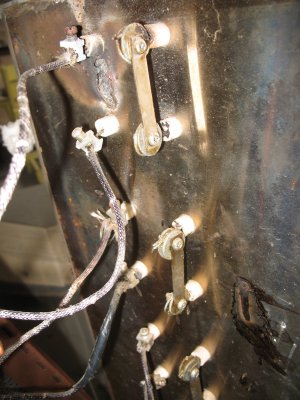
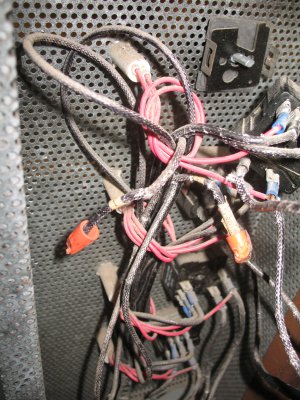
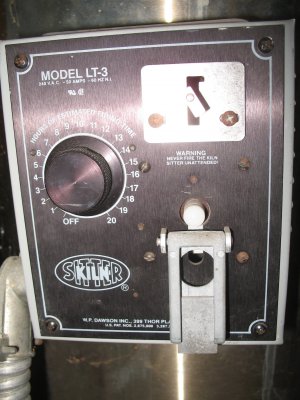
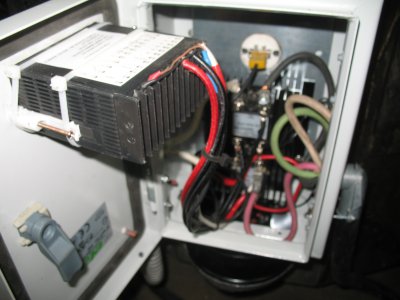
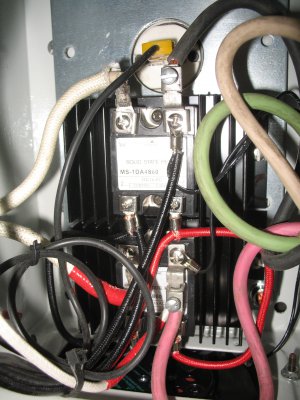
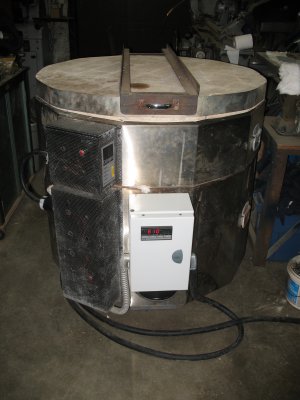
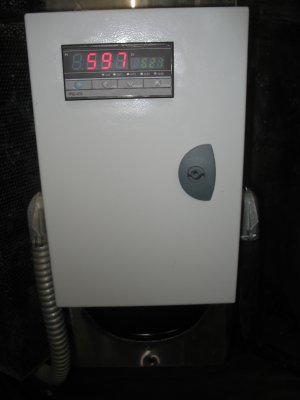
Nice build so far.
I have been refitting a ceramic kiln for a client.
So far it has gone very well. I used a Ramp & Soak controller from Thermomart, along with 2 - 60A SSRs and the large heatsinks for them.
Got finished the rebuild a couple of days ago and then did a few test fires and found out something interesing about the SSRs. They give of plenty of heat.
Day one firing got to over 800C and noticed that the electrical box which I had used to wire everything up in was reading about 130 F (55 C) and was very concerned with how long the R&S controller was going to last at that temperature. Next day I tried again, this time paying close attention to the temperature of the box and found that it was heating up and the kiln was not even warm yet, so it was the heat from the SSRs that was causing the problem. So I ordered in a 220V Duct fan, 230 CFM and ran it into the bottom of the electrical box, easy as there was already an access hole there and now even at 1107 C the box is still cold to the touch.
First pictures was the mess of burnt wires that ws in there to start with, then the new box with controls and the kiln doing a test firing.
The fan is the round black item at the bottom of the control box.
Walter







- Joined
- Nov 16, 2012
- Messages
- 5,596
Walter,
Good Grief... Please check to see if the SSRs are rated for AC. They might be DC only and running AC through them will warm them up pretty quick. As a point of reference, mine is rated for 40A and I'm putting 20-25 through it. It would take a good while for one to melt an ice cube. They barely get warm to the touch. If you need to replace yours, the supplier is listed somewhere at the bottom of this thread.
Also, the low voltage side of the SSRs are polarized on some units. -And some have DC on the low side but will pass AC. They come in many configurations...
Good luck and I hope you figure it out... and I hope it was just a matter of proper ventilation.
Ray
Good Grief... Please check to see if the SSRs are rated for AC. They might be DC only and running AC through them will warm them up pretty quick. As a point of reference, mine is rated for 40A and I'm putting 20-25 through it. It would take a good while for one to melt an ice cube. They barely get warm to the touch. If you need to replace yours, the supplier is listed somewhere at the bottom of this thread.
Also, the low voltage side of the SSRs are polarized on some units. -And some have DC on the low side but will pass AC. They come in many configurations...
Good luck and I hope you figure it out... and I hope it was just a matter of proper ventilation.
Ray
- Joined
- Sep 22, 2010
- Messages
- 898
Ray
http://www.thermomart.com/ac-dc-relay-heatsink/ssr-
They are rated 24 to 480V AC, with a 3 to 32 VDC input.
My biggest problem is that the heatsinks are both inside a NEMA 4 enclosure, so there is no way they can breathe. I wanted a box that was full of holes like the covers over the element connectors, but no such luck, could not find anything that was available; especially that was CSA / ULc rated, and since the R&S controller was being mounted on the front panel, it had to be a hinged door according to the electrical code which left me with the NEMA4 box.
If the heatsinks were mounted outside the box that would be better, but the SSR mounts in a slot in the heatsink and to put it outside would mean that the wires would be exposed.
Also the head of the K type thermocouple comes out in the box just above the heatsinks, and in checking that could be a major source of the heat in the box. I did insulate around the thermocouple both from inside the Kiln and from the outside under the mount for the box, but even now, I could feel heat coming from the white ceramic part of the thermocouple, and the heatsinks for the SSRs were cold. Kiln was still at above 500 C when I just checked this, so maybe the problem is not the SSRs after all. At any rate, the fan keeps things nice and cool inside the box and being an idustrial rated, ball bearing fan should last a long time.
This unit is rated at 43.8 Amps on 240V, has six pairs of heating coils, each at 1750 watts for a total rating of 10,500 watts.
Walter
http://www.thermomart.com/ac-dc-relay-heatsink/ssr-
They are rated 24 to 480V AC, with a 3 to 32 VDC input.
My biggest problem is that the heatsinks are both inside a NEMA 4 enclosure, so there is no way they can breathe. I wanted a box that was full of holes like the covers over the element connectors, but no such luck, could not find anything that was available; especially that was CSA / ULc rated, and since the R&S controller was being mounted on the front panel, it had to be a hinged door according to the electrical code which left me with the NEMA4 box.
If the heatsinks were mounted outside the box that would be better, but the SSR mounts in a slot in the heatsink and to put it outside would mean that the wires would be exposed.
Also the head of the K type thermocouple comes out in the box just above the heatsinks, and in checking that could be a major source of the heat in the box. I did insulate around the thermocouple both from inside the Kiln and from the outside under the mount for the box, but even now, I could feel heat coming from the white ceramic part of the thermocouple, and the heatsinks for the SSRs were cold. Kiln was still at above 500 C when I just checked this, so maybe the problem is not the SSRs after all. At any rate, the fan keeps things nice and cool inside the box and being an idustrial rated, ball bearing fan should last a long time.
This unit is rated at 43.8 Amps on 240V, has six pairs of heating coils, each at 1750 watts for a total rating of 10,500 watts.
Walter
- Joined
- Nov 16, 2012
- Messages
- 5,596
Gotcha... That's a lot of current so, it probably generates a lot more heat than mine. BTW: When I mounted the SSRs to the heatsink, I noticed the machined surfaces were not perfectly flat on the SSR so, I used thermal paste to help transfer the heat. This is common practice on heat sinks and vastly improves the efficiency of heat transfer to the sink. Just look for "thermal paste". Cheap stuff. It won't change the amount of heat inside the box but it will take it away from the semi-conductors and make them last longer.
Too bad there's not a way you could modify the box so the sink fins were outside but if this is for commercial use, you probably need to keep it all enclosed.
.... Just out of curiosity, what's the max temperature inside that thing? 10500 Watts... Yikes...
Ray
Too bad there's not a way you could modify the box so the sink fins were outside but if this is for commercial use, you probably need to keep it all enclosed.
.... Just out of curiosity, what's the max temperature inside that thing? 10500 Watts... Yikes...
Ray
Last edited:
- Joined
- Sep 22, 2010
- Messages
- 898
Max temp is 2350 Deg F (1287.78 C) Also bear in mind the size of this thing, 36 In diameter outside by 37" high, so close to 30 x 30 inside chamber. The chamber is in two sections, four sets of coils in the lower section and two sets in the upper ring section that can be removed to make it a smaller kiln, or to make it easier for transport.
I have been using the proper dialectric compound for heat sinks for years, or at least since I majored in electronics when I was about 16
Yes since this is going to a pottery studio, and there are others around, including small children, I have to make sure it is done to code and that there are no exposed parts. If I got a different style of heatsink, then I could set up something so the fins are outside, but not with this set of heatsinks that were supplied with the SSR's.
If I had a different style of thermometer like the one you have, I could possible spot for hot spots, but mine has a metal contact point, and I ain't stickin' it into a live circuit box.
I am sure that a good part of the heat is coming from the thermocouple, but it was not possible to remotely mount it as the hole for it was already there and there would have been exposed wires if I mounted the box in a different spot.
So far, all is well and it is running really well. Just has a fan humming away any time the power is turned on.
Walter
I have been using the proper dialectric compound for heat sinks for years, or at least since I majored in electronics when I was about 16
Yes since this is going to a pottery studio, and there are others around, including small children, I have to make sure it is done to code and that there are no exposed parts. If I got a different style of heatsink, then I could set up something so the fins are outside, but not with this set of heatsinks that were supplied with the SSR's.
If I had a different style of thermometer like the one you have, I could possible spot for hot spots, but mine has a metal contact point, and I ain't stickin' it into a live circuit box.
I am sure that a good part of the heat is coming from the thermocouple, but it was not possible to remotely mount it as the hole for it was already there and there would have been exposed wires if I mounted the box in a different spot.
So far, all is well and it is running really well. Just has a fan humming away any time the power is turned on.
Walter
Last edited:
